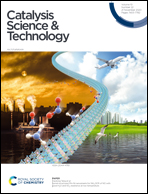Ligand electronic fine-tuning and its repercussion on the photocatalytic activity and mechanistic pathways of the copper-photocatalysed aza-Henry reaction†
Abstract
A family of six structurally related heteroleptic copper(I) complexes of the form of [Cu(N^N)(P^P)]+ bearing a 2,9-dimethyl-1,10-phenanthroline diimine (N^N) ligand and a series of electronically tunable xantphos (P^P) ligands have been synthesized and their optoelectronic properties characterized. The reactivity of these complexes in the copper-photocatalyzed aza-Henry reaction of N-phenyltetrahydroisoquinoline was evaluated, while the related excited state kinetics were comprehensively studied. By subtlety changing the electron-donating properties of the P^P ligands with negligible structural differences, we could tailor the photoredox properties and relate them to the reactivity. Moreover, depending on the exited-state redox potential of the catalysts, the preferred mechanism can shift between reductive quenching, energy transfer and oxidative quenching pathways. A combined study of the structural modulation of copper(I) photocatalysts, optoelectronic properties and photocatalytic reactivity resulted in a clearer understanding of both the rational design of the photocatalyst and the complexity of competing photoinduced electron and energy transfer mechanisms.



 Please wait while we load your content...
Please wait while we load your content...